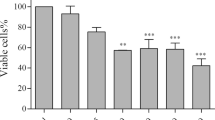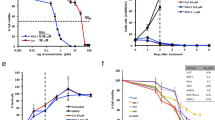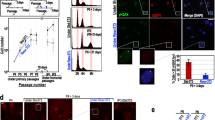Abstract
Resveratrol, a constituent of grapes and other foods, has been reported to be a potential cancer chemopreventive agent. Our previous study showed that the antitumor activity of resveratrol occurs through mitogen-activated protein kinases-mediated p53 activation and induction of apoptosis. To develop more effective agents with fewer side effects for the chemoprevention of cancer, we investigated the effect of resveratrol and its structurally related derivatives on epidermal growth factor (EGF)-induced cell transformation. Our results provided the first evidence that one of the resveratrol derivatives exerted a more potent inhibitory effect than resveratrol on EGF-induced cell transformation, but had less cytotoxic effects on normal nontransformed cells. Compared to resveratrol, this compound also caused cell cycle arrest in the G1 phase, but did not induce p53 activation and apoptosis. Furthermore, this compound, but not resveratrol, markedly inhibited EGF-induced phosphatidylinositol-3 kinase (PI-3K) and Akt activation. Collectively, these data suggested that the higher antitumor effect of the compound compared to resveratrol, may act through a different mechanism by mainly targeting PI-3K/Akt signaling pathways.
This is a preview of subscription content, access via your institution
Access options
Subscribe to this journal
Receive 50 print issues and online access
$259.00 per year
only $5.18 per issue
Buy this article
- Purchase on Springer Link
- Instant access to full article PDF
Prices may be subject to local taxes which are calculated during checkout






Similar content being viewed by others
References
Adhami VM, Afaq F and Ahmad N . (2001). Biochem. Biophys. Res. Commun., 288, 579–585.
Ahmad N, Adhami VM, Afaq F, Feyes DK and Mukhtar H . (2001). Clin. Cancer Res., 7, 1466–1473.
Bernstein LR and Colburn NH . (1989). Science, 244, 566–569.
Clement MV, Hirpara JL, Chawdhury SH and Pervaiz S . (1998). Blood, 92, 996–1002.
Collado M, Medema RH, Garcia-Cao I, Dubuisson ML, Barradas M, Glassford J, Rivas C, Burgering BM, Serrano M and Lam EW . (2000). J. Biol. Chem., 275, 21960–21968.
Coughlin SR, Escobedo JA and Williams LT . (1989). Science, 243, 1191–1194.
Datta SR, Brunet A and Greenberg ME . (1999). Genes Dev., 13, 2905–2927.
Diehl JA, Cheng M, Roussel MF and Sherr CJ . (1998). Genes Dev., 12, 3499–3511.
Dong Z, Birrer MJ, Watts RG, Matrisian LM and Colburn NH . (1994). Proc. Natl. Acad. Sci. USA, 91, 609–613.
Dong Z, Huang C and Ma WY . (1999). Anticancer Res., 19, 3743–3747.
Edinger AL and Thompson CB . (2002). Mol. Biol. Cell, 13, 2276–2288.
el-Deiry WS, Kern SE, Pietenpol JA, Kinzler KW and Vogelstein B . (1992). Nat. Genet., 1, 45–49.
Hong WK and Sporn MB . (1997). Science, 278, 1073–1077.
Hsieh TC and Wu JM . (1999). Exp. Cell Res., 249, 109–115.
Huang C, Li JX, Ma WY and Dong Z . (1999a). J. Biol. Chem., 274, 29672–29676.
Huang C, Ma WY and Dong Z . (1996). Mol. Cell. Biol., 16, 6427–6435.
Huang C, Ma WY, Goranson A and Dong Z . (1999b). Carcinogenesis, 20, 237–242.
Huang C, Ma WY, Hecht SS and Dong Z . (1997a). Cancer Res., 57, 2873–2878.
Huang C, Ma WY, Ryan CA and Dong Z . (1997b). Proc. Natl. Acad. Sci. USA, 94, 11957–11962.
Jang M, Cai L, Udeani GO, Slowing KV, Thomas CF, Beecher CW, Fong HH, Farnsworth NR, Kinghorn AD, Mehta RG, Moon RC and Pezzuto JM . (1997). Science, 275, 218–220.
Kaplan DR, Whitman M, Schaffhausen B, Pallas DC, White M, Cantley L and Roberts TM . (1987). Cell, 50, 1021–1029.
Kelloff GJ, Crowell JA, Steele VE, Lubet RA, Malone WA, Boone CW, Kopelovich L, Hawk ET, Lieberman R, Lawrence JA, Ali I, Viner JL and Sigman CC . (2000). J. Nutr., 130, 467S–471S.
Levine AJ . (1997). Cell, 88, 323–331.
Park JW, Choi YJ, Suh SI, Baek WK, Suh MH, Jin IN, Min DS, Woo JH, Chang JS, Passaniti A, Lee YH and Kwon TK . (2001). Carcinogenesis, 22, 1633–1639.
Prives C and Hall PA . (1999). J. Pathol., 187, 112–126.
Ragione FD, Cucciolla V, Borriello A, Pietra VD, Racioppi L, Soldati G, Manna C, Galletti P and Zappia V . (1998). Biochem. Biophys. Res. Commun., 250, 53–58.
Serunian LA, Auger KR, Roberts TM and Cantley LC . (1990). J. Virol., 64, 4718–4725.
She QB, Bode AM, Ma WY, Chen NY and Dong Z . (2001). Cancer Res., 61, 1604–1610.
She QB, Huang C, Zhang Y and Dong Z . (2002). Mol. Carcinog., 33, 244–250.
She QB, Mukherjee JJ, Huang JS, Crilly KS, and Kiss Z . (2000). FEBS Lett., 469, 163–167.
Sporn MB and Suh N . (2000). Carcinogenesis, 21, 525–530.
Stein RC and Waterfield MD . (2000). Mol. Med. Today, 6, 347–357.
Subbaramaiah K, Chung WJ, Michaluart P, Telang N, Tanabe T, Inoue H, Jang M, Pezzuto JM and Dannenberg AJ . (1998). J. Biol. Chem., 273, 21875–21882.
Surh YJ, Hurh YJ, Kang JY, Lee E, Kong G and Lee SJ . (1999). Cancer Lett., 140, 1–10.
Tsai SH, Lin-Shiau SY and Lin JK . (1999). Br. J. Pharmacol., 126, 673–680.
Viglietto G, Motti ML, Bruni P, Melillo RM, D'Alessio A, Califano D, Vinci F, Chiappetta G, Tsichlis P, Bellacosa A, Fusco A and Santoro M . (2002). Nat. Med., 8, 1136–1144.
Wang M, Jin Y and Ho CT . (1999). J. Agric. Food Chem., 47, 3974–3977.
Zhou BP, Liao Y, Xia W, Spohn B, Lee MH and Hung MC . (2001). Nat. Cell. Biol., 3, 245–252.
Acknowledgements
We thank Dr Ann M Bode for critical reading of the manuscript, Patricia Schmid for analysis of cell cycle and apoptosis, Qing Ye for help with some experiments and Andria Hansen for secretarial assistance. This work was supported in part by The Hormel Foundation, American Institutes for Cancer Research Grant 99A062, and National Institutes of Health Grants CA77646 and CA81064.
Author information
Authors and Affiliations
Corresponding author
Rights and permissions
About this article
Cite this article
She, QB., Ma, WY., Wang, M. et al. Inhibition of cell transformation by resveratrol and its derivatives: differential effects and mechanisms involved. Oncogene 22, 2143–2150 (2003). https://doi.org/10.1038/sj.onc.1206370
Received:
Revised:
Accepted:
Published:
Issue Date:
DOI: https://doi.org/10.1038/sj.onc.1206370
Keywords
This article is cited by
-
Profiling of insulin and resveratrol interaction using multi-spectroscopy and molecular docking study
Beni-Suef University Journal of Basic and Applied Sciences (2022)
-
Marine natural products with anti-inflammatory activity
Applied Microbiology and Biotechnology (2016)
-
Advanced dynamic monitoring of cellular status using label-free and non-invasive cell-based sensing technology for the prediction of anticancer drug efficacy
Analytical and Bioanalytical Chemistry (2010)
-
Rapid and quantitative method for evaluating the personal therapeutic potential of cancer drugs
Analytical and Bioanalytical Chemistry (2008)
-
Post-translational modification of p53 in tumorigenesis
Nature Reviews Cancer (2004)



